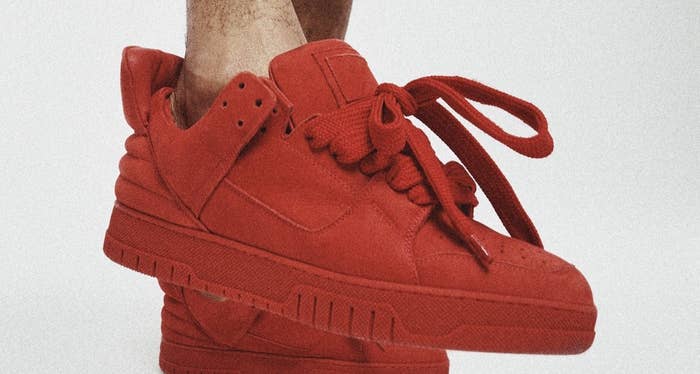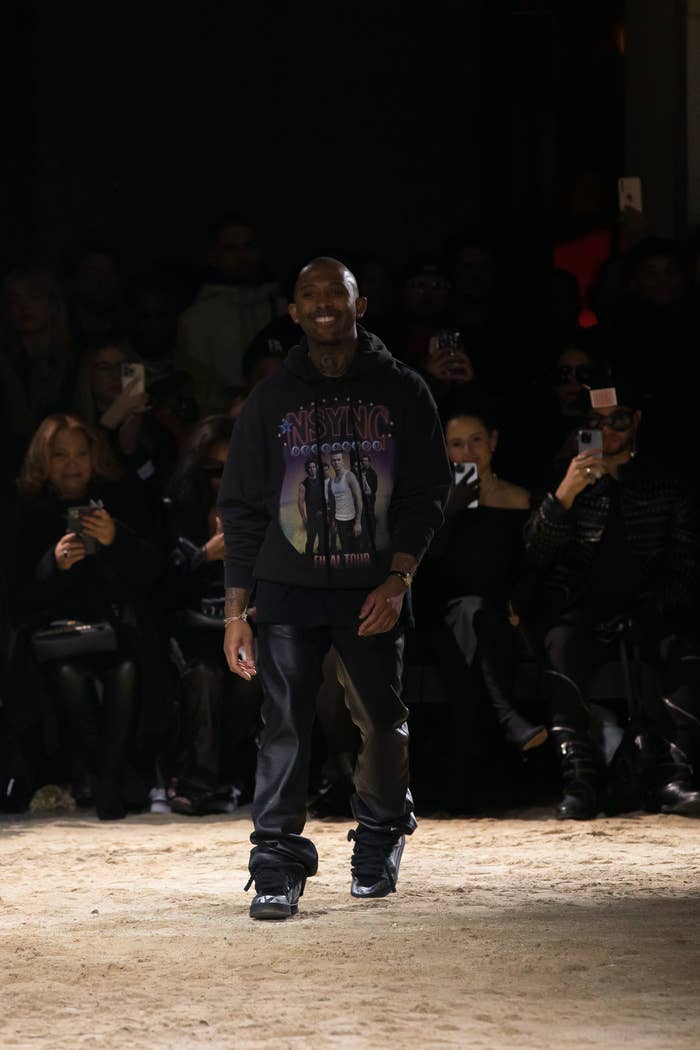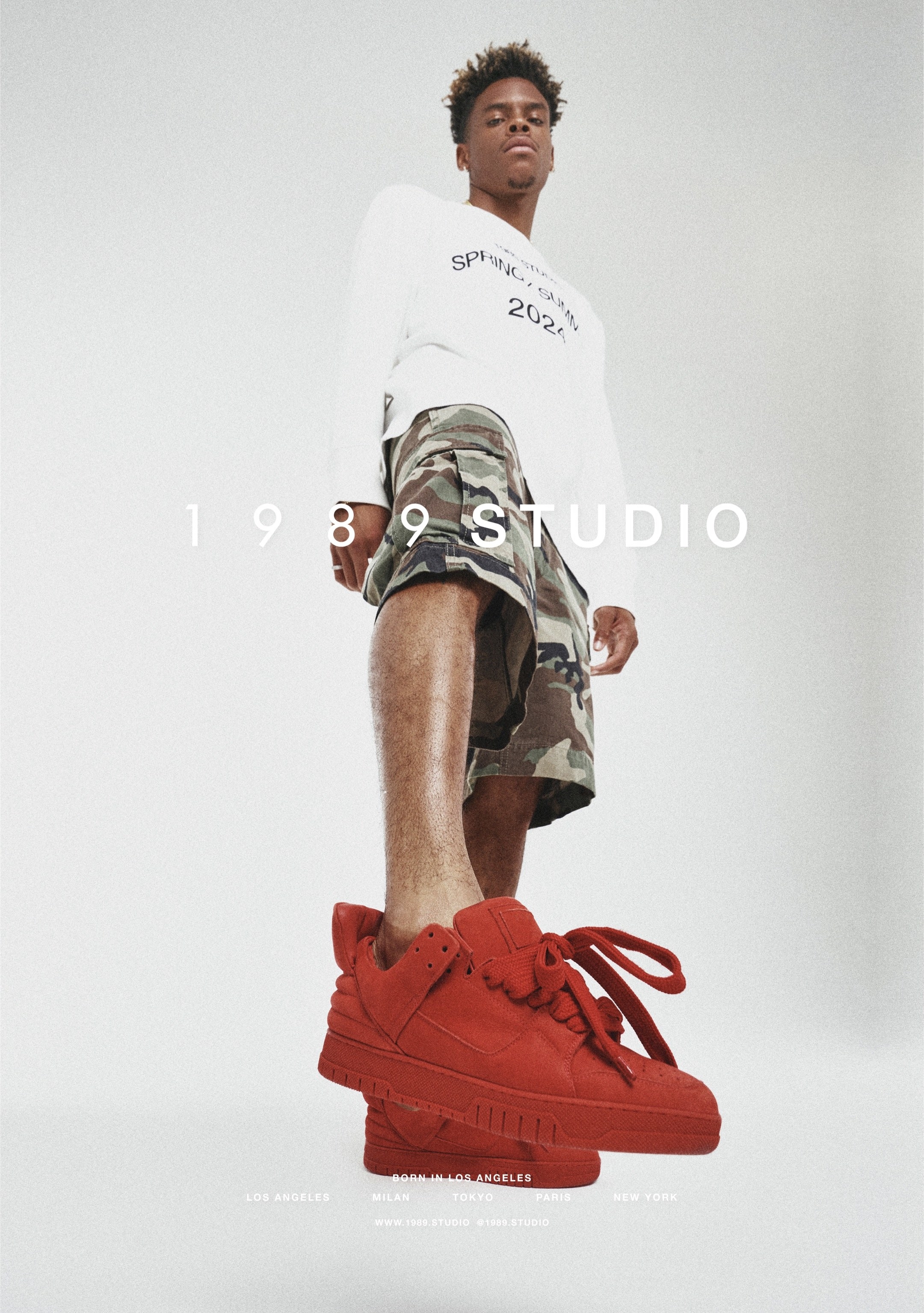
Chaz Jordan still regrets not buying a pair of Louis Vuitton Dons in 2009. A student at the University of Illinois at the time, Jordan still remembers the impact that the sneaker had on him.
“That was me at the beginning of my experience with the luxury market,” says Jordan, who recalls shopping on streetwear sites like Karmaloop for the latest LRG and Supra gear before immersing himself into luxury fashion. The LV Dons were a gateway. “I should have copped multiple pairs in retrospect. But I slept and it was like one of the biggest decisions that I regret.”
14 years later, Jordan isn’t just a consumer. He’s designing his own collections for his brand 1989 Studio, which he founded in 2021. Currently, he’s prepping the second Paris Fashion Week presentation for the brand, which will take place on June 25. While he isn’t a classically trained designer, he’s had a lot of practice with his previous ventures, Au Courant and Ih Nom Uh Nit (remember those hoodies with Eleven’s face on them?). But Jordan says the resources at his disposal now are the most he’s ever had. They’re allowing him to execute his vision to the fullest.
“This is the first time in my career that I've ever had those resources,” says Jordan. “Those other brands that you've mentioned, it was me. Now, it’s thinking about what's possible with a team at that level. It’s endless.”
Part of that vision is the introduction of the “Red October” Skate Low V01 (€450), his homage to the all-red Louis Vuitton Dons that have eluded him for years from an era that he says was so pivotal to his outlook on fashion. The pair will make its official debut on the runway this Sunday. The silhouette also channels the Nike SB Dunk Low with a similar shape and cushioning, so that they can actually be skated in. But its defining feature is the puffy, elevated heel panel, the clearest nod to the Dons.
“I'll pay homage to certain things like this and I try not to do it as much as possible unless I really feel that it hasn't been done. Had another brand done it, I wouldn't have touched it,” says Jordan. “It was such an important moment for us all and everybody's looking to get that shoe, but nobody wants to put up that money. It just felt right to do it and to give something back to all of us that were a part of that and are still looking to relive that by purchasing those shoes."
He says that he plans to gift pairs to longtime mentors like Don C who, alongside Virgil Abloh, helped introduce him to the fashion industry while he worked at RSVP Gallery in 2011. Other names include pop stars like Justin Bieber and he is even making a pair for North West. Will Ye be getting a pair? Maybe.
“If the moment is right, I'll send it out. But I don't even think he will wear it just because of where he's at right now. You see what Ye’s wearing. It's very anti that. And I understand.”

The sneakers are just one piece of 1989 Studio’s upcoming show, which is gearing up to be its biggest to date. To bring it to life, Jordan worked with PlayLab, the creative studio who handled the production of nearly all of Abloh’s Louis Vuitton shows. Jordan says he and PlayLab founder Archie Lee Coates IV immediately connected. Needless to say, he’s excited to show the world what the two have cooked up on Sunday.
“When you finally feel that you found someone that understands you creatively, that's another thing that I could never describe to you,” says Jordan. “And then pair that with the person who has done all of the production for Virgil at LV, so you know that they're capable of realizing whatever you can imagine. Archie has gone above and beyond.”
He describes what we will see walking down the runway as the third phase of 1989 Studio. Its debut collection channeled classic Americana with western-inspired graphics and workwear like tobacco-colored double knee pants. The second, which consisted of all-black looks incorporating leather moto pants and a graphic akin to Givenchy’s iconic Rottweiler T-shirt, was him teleporting us back to 2013 when he was living in Paris.
For the latest installment, Jordan describes it as senior year of high school in Santa Monica. Campaign images give a peak into what that entails, jeans with Evisu-esque leather panels across the back of the legs, mohair sweaters, cropped white T-shirts, and a graphic that fuses the logos of the Chicago White Sox and Los Angeles Dodgers (Jordan split between the two cities in the 2010s). His plan is to take the bits from each phase that resonated most with customers and fuse them together to define the brand’s future collections.
Ahead of this weekend’s show, we spoke with Jordan to learn more about the debut of his LV Don-inspired sneaker, working with PlayLab, the future of 1989 Studio, and more.
This interview has been edited and condensed for clarity.
What makes the Louis Vuitton Don so special to you?
I was heavy into Kanye at the time when I was in college. My first camp out for a pair of sneakers were the Nike Air Yeezy 1s. The first time I met Ye was around the time when Graduation released. So, I was very heavy into the world of Ye. When those shoes came out, I had a personal shopper at the LV store in downtown Chicago on Michigan Avenue. She handled all of the VIPs and the celebrities. So, for me to even have that contact and for her to text me…like I'm a college kid [Laughs.] She would text me the PDFs of what’s coming through the store before it got there.
Me being immersed in that whole world, it was just like, “Yo, I have to have these shoes.” That was me at the beginning of my experience with the luxury market. I was introduced to Barney's around that time. That's when we were wearing Balenciaga Arenas. So, that time just really stuck with me. And funny enough, I didn't even end up buying the shoes. I probably didn't even have the bread or whatever the case may have been. I should have copped multiple pairs in retrospect. But I slept and it was like one of the biggest decisions that I regret. [Laughs.]
So it’s much more personal than just referencing an iconic pair of sneakers.
For sure. It's very personal. I was obsessed with that shoe. So I was like, “Yo, if I can't find these shoes for less than five racks, I'm gonna make ‘em.”

Early in your career you were working alongside Don C and Virgil Abloh. Did that put you in rooms with Ye? Did you end up working on anything with him in any sort of capacity at the time?
I had met him a few times through him pulling up to [RSVP Gallery], and then in Paris at Virgil's Off-White launch at Colette. But it was never in a work capacity. I was mainly with Virgil when he was in town at the shop, and then with Don more so on a day-to-day, which is why my closest relationship is with Don to this day. I was legit with Don like everyday in Chicago.
What’s the biggest lesson that you learned from being around Virgil and Don at that time that you’ve carried with you in your career?
The biggest lesson that I've always taken from those two was just my experience in it. They showed that it was possible and accessible. To be exposed to the world through that lens, you can't pay for that type of experience. You just see so many things that a lot of people only see on Instagram or on TV. Experiencing it firsthand really gave me the attitude and the mindset of, “This is possible because this is just my homie who's doing this.” It's like you growing up with your brother and he becomes like Michael Jordan. [Laughs.] So, that was kind of the mentality and the mindset that I had. I mean, I'm literally on this call in Paris about to have a show in a few days, so you can tie a direct thread.
Have you put that into perspective yet, the growth in your career from then to now?
I mean, not really, because when you're in it, you're just experiencing it. Even when we would have small shows, it felt big and the impact was big because Complex would cover it. This magazine would cover it. You felt that it was much bigger than it was. So now it’s just continuing to do it but with a much bigger audience and a much bigger stage. But for me, the mentality and the approach is exactly the same.
That feeling that you're asking about usually comes when we finish the finale and we come backstage. That's when that rush of emotion hits you. This is why most designers cry as soon as they come back. It's a really hard emotion to contain. I'm not that type of person at all, but it just hits you instantly.
It's like the ultimate exhale.
It really is. You're on such a high and then it's just the release.
Did you always know you had to debut this sneaker during Paris Fashion Week? Were there other ideas?
For me, it was about the touch points that I can hit to where when people see it, they can have an immediate callback. Obviously, Paris is a tie in. You just had the LV show with Pharrell, which was a coincidence. So I feel like all of these things are happening and the momentum is happening that is just supporting the drop. But we couldn't have planned for a lot of these things to happen. I think that it was a combination of us planning this strategically and then the universe adding some extra sauce.
Quick side note because you brought it up, what did you think of Pharrell’s LV presentation?
I think it was solid. I'm always looking at the production first and foremost. I think that was a historic moment for the house, for the city, and then obviously for him because of that location. I can only imagine the logistics that they had to go through for that, but the production was solid. I felt that there were a lot of pieces that resonated with him and I think translated very well to the LV brand.
Is seeing that a further motivator for you at all, seeing someone like Pharrell after all these years getting to present a collection with LV?
Not so much a motivator. I was more so proud in a weird way. And I've never even met Pharrell, but just to see him and know what that meant to him was like, “Yo, I'm happy that went so well for him.”

Shifting gears back to the sneaker, given what it is referencing, what do you feel like Ye’s impact on fashion is?
I mean that's hard to describe in a comment. [Laughs.] I don't even have enough words to really properly formulate a response. We'll probably feel that impact for our lifetime and then you'll probably even feel it through the next generation.
There were phases. That was our introduction to the world of luxury, to Paris, to this level of fashion. He showed us that this was possible and allowed us to start kicking these doors in. Then you had the next wave, which was Yeezy, Gap, and Adidas. You have two different groups that experienced his impact in fashion in two different time periods.
The shoe also has a Nike SB Dunk influence. Can you just talk about how skate inspires your work overall?
For me, it was always to bridge that gap. That's how we dress. And to tie it back to Pharrell on that note, he was such a huge impact on our fashion and our style at that time, as well as Ye and Lupe [Fiasco]. That was the trifecta from which a lot of us pulled our style cues at the time. I feel like my style cues and tastes probably resonate more with P than they do with Ye. That's where the skate and the street element comes into play. It was the comfort of the T-shirt with the hoodie. The hoodie may have been crocodile leather, and then you have the jeans with sneakers and an iced out keychain. It was casual, but when you break it down, it's actually substantial. I just try to continue that narrative.
Can you skate the shoes?
They're skateable. The design cues that I gave to the team were to basically build the shoe as if it were an SB Dunk. So you have the gel pad under the heel, the structure of the shoe, the cushion, and the support. It’s meant to be skated in. And then I gave the shoe to [pro skater] Robert Neal. The first question I asked was like, “Could you actually skate in this?” And he was like, “This is one of the most comfortable skate shoes I've ever had.” For me, that was the validation that we made a solid product.
Can you talk a bit more about what went into actually producing the sneaker?
I was really big on the comfort and the materials. There were a lot of trials and tests back and forth to really nail it. It was super tedious, more padding here, less padding there. I think we were in development for around six months, which is relatively quick. Most shoes take 10 to 12 months.
Given the reference points of the sneaker, are you worried about that C&D?
Nah. [Laughs.] I don't think so. I doubt we'll get that.
I'll pay homage to certain things like this and I try not to do it as much as possible unless I really feel that it hasn't been done. Had another brand done it, I wouldn't have touched it. If they were still producing that shoe or anything remotely similar, I wouldn't have touched it. But it was such an important moment for us all and everybody's looking to get that shoe, but nobody wants to put up that money. It just felt right to do it and to give something back to all of us that were a part of that and are still looking to relive that by purchasing those shoes.
There’s this sneaker. You have Jesus pieces on your site right now. What about that era of style, the late 2000s and early 2010s, really resonates with you?
It was really when I was coming into my own. It’s so pivotal to everything that I do and it's so ingrained in my mind. People will categorize a time period as before this moment happened and after this moment happened. That was my defining moment, going from copping Supras and LRG on Karmaloop to looking at what these Parisian designers were doing. So a lot of my callbacks are to those moments. I just try to recreate the feeling and the emotion that we all had.
You're presenting your second collection on the last day of Paris Fashion Week. Other than this sneaker that we've been talking about, what can we expect from that presentation?
This was all a part of my strategy from the beginning. I try to think as far ahead as possible because I'm trying to world build. I typically design two to three seasons in advance because I have such a long-term play in mind. So, I split the initial release into three phases. The first phase was SS23. What if 1989 owned a dude ranch? What would that look like? The second release was taking you back to Paris in 2013 when we were wearing all black.
This collection is taking you to LA in the early 2010s. So, it was literally following my progression. I'm giving you a glimpse and a look into each of the periods that influenced me the most. I'm just trying to transport the people into that moment. So now you're entering a high school courtyard in Santa Monica in the 2010s. You’re a senior. You're pulling up to class in pajama bottoms with a fucking blazer, a T-shirt with your gym shorts. You really don't care. You’re just trying to get outta high school. So that's the theme of this collection.
I did such drastically different collections as a kind of test. I'm going to take an assessment to see what people gravitated towards the most and I will use that to solidify what 1989 will become.
What have you learned from your previous brands Au Courant and Ih Nom Uh Nit that have helped you execute 1989 at a higher level?
It's a cheat code really. You just learn from trial and error along the way. I'm not properly taught. That was the only way. And then you just figure out what works best for what you need. That's all it's been over the past 11 years. It's fine tuning. I think the next show is where we will firmly establish our position. Now, we have basically all of the core people that you need to start a brand successfully. These team members are people that we've pulled from some of the biggest groups in fashion. This is the first time in my career that I've ever had those resources. Those other brands that you've mentioned, it was me. Now, it’s thinking about what's possible with a team at that level. It’s endless.

